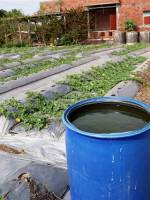
Could you please discuss the recent trends that you’ve observed in the powder coatings industry, both globally and within the region?
Jirak: We’re observing a shift from liquid to powder, mainly due to the environmental advantages, particularly the absence of VOCs (volatile organic compounds). This started about 15 years ago in Europe, and has moved into North America and Asia.
One other important element is aesthetics. Powder coatings offer a wide range of aesthetic options, from the entire color palette to different finishes on the surfaces, including matt, glossy, metallic looks, or the newly-introduced stone or wood grain effects.
The third trend is about durability. With certain powder coatings, we can offer up to a 30-year warranty in exterior architectural applications (when applied by an Interpon D Approved Applicator).
Finally, the fourth area of high growth is functional resins which are useful for resistance of electrical conductivity, most commonly used in the battery compartment of electric vehicles (EVs). These functional technologies are taking off, so powder coating is very much a growing market.
How will the recent expansion in Bac Ninh help AkzoNobel stay ahead of the curve?
Jirak: AkzoNobel is a market leader in powder coatings globally, with over 31 manufacturing sites with local solution laboratories around the world. Additionally, there are also central R&D locations in each region. These operations are science-driven, based on what the customers need in the various market segments that we serve.
Vietnam is one of our key growth countries in Southeast Asia, with a really big influx of business from China. With the country being a significant manufacturing hub and metal fabrication being a core manufacturing element of the Vietnamese market, powder coatings are really taking off here. Additionally, outdoor architectural applications have historically been a strong segment for AkzoNobel in the region. We need the capacity to service that growth, which is why these new lines are in place to satisfy customers’ needs.
Canıtez: The products we manufacture in Vietnam serve not only domestic demand but also other regional markets. In Bac Ninh we have installed five brand new state-of-the-art lines with high automation, with the main aim to boost capacity and meet the rising demand.
In a sense, it all comes back to sustainability and customer-centricity. The expansion will allow our Dong Nai site to focus on supporting volume growth in southern Vietnam, which in turn enhances our ability to offer customers more competitive shipping times in the North while reducing our environmental footprint. By making the wise choice in terms of putting the right plants and distribution centres in the right locations, we aim to minimize our impact on the environment.

What level of significance does sustainability hold within AkzoNobel’s production lines?
Jirak: Sustainability is at the core of what we do. In fact, we lead the market in eco-friendly powder coatings with no VOCs. We focus on the end-to-end life cycle of our products and working with customers to find ways to lower our environmental footprint, including experimenting with a circular partnership with customers to utilize recycled content.
Our focus extends to sustainable production processes, including recirculation capabilities, minimizing wastewater, and lowering processing temperatures.
In addition, a lot of our sustainability work is geared towards helping our customers as we collaborate closely with them to tailor solutions that align with their sustainability goals. This includes offering lower temperature cure products to reduce energy and even increase usage throughput. Lower curing temperatures also open powder to a wider variety of substrates, like wood.
Our contributions to EV technologies, through protecting battery packs and cooling coils, indirectly support our broader environmental objectives.
Canıtez: Our three pillars of sustainability include climate change, circularity, and people’s health and wellbeing. Our key ambitions as a company are to halve our carbon emissions by 2030, derive 50 per cent of our revenue from sustainable solutions, achieve 100 per cent circular use of materials, and empower over 100,000 individuals in local communities with new skills.
Our recent investment at Bac Ninh site ticks all the boxes. First, it improves logistics and reduces carbon footprints by cutting shipping times in northern Vietnam, as I mentioned. Second, as the processes are more streamlined with new equipment installed to recycle without affecting product quality, we can keep the use of raw materials at the optimal level. Lastly, this investment with advanced technology also enables us to safeguard the health and wellbeing of our employees, customers and other stakeholders in the communities we operate in Bac Ninh.
In collaborating with partners, what is your assessment of the Vietnamese market’s readiness to embrace sustainability commitments?
Canıtez: More and more customers are asking about sustainability-related topics, which is extremely positive. It surprises me that some of them are not even multinationals but relatively sizable local companies trying to find out where they can start this journey from.
So, as we are trying to understand our suppliers and our own footprint, we are also attempting to assist our customers. It’s really an end-to-end process tackling the full value chain.
Looking ahead, what are the strategic priorities and goals for AkzoNobel’s powder coatings business in the Southern Asia-Pacific region?
Jirak: As the market leader in powder coatings, we are expected to set the tone in innovation. As we move forward, we are staffed and resourced to continue to be the innovation leader and help customers reach their own sustainability targets and ambitions.
Our innovation is focused on three key areas: product performance, aesthetics, and processing. In terms of performance, besides the work on advancing durability, we are designing new resins that can cure at lower temperatures and still give the same level of performance. This trade-off represents an optimization on product performance. Late last year we already set an industry first with the launch of our architectural powder range with curing temperatures 30°C lower than the competition.
In terms of aesthetics, our Bac Ninh facility now includes a dedicated bonding unit that can produce bonded metallics – a very strong and durable metallic looking powder. While the challenge is safe production, as bonding with aluminium flakes is highly flammable, the innovation allows us to produce some of the most remarkable metallic finishes one can imagine.
As for processing, our innovation is evident in our recent co-development of artificial intelligence (AI)-driven software called Flightpath Pro, together with coating AI, which enhances application processes and reduces our carbon footprint by optimizing equipment settings, reducing defects, overspray, and improving powder and energy consumption.
As our Bac Ninh site now has all the equipment for these three elements of innovation, the recent expansion is positioning Bac Ninh as a hub for cutting-edge developments in the region.
Canıtez: Like all the other multinationals, we go through a three-to-five-year strategic cycle and then make our long-term plans accordingly. So far, we have been a great player when it comes to the premium tier. But if you think about it, it’s roughly one-third of the whole market, considering the mid and low-tier segments.
Looking ahead, we plan to keep growing our market share organically on the premium side, but also increase our presence in the mid-market. That means providing our customers with a broader variety of solutions, depending on what they exactly need. That is expected to drive growth in the coming period for us, especially in Vietnam, which will also be enabled by these new investments.
Simultaneously, we aim to explore new spaces, as Jirak noted, such as powder on wood, EV-related products, and low-cure options. Diversifying our product range will also enhance our position by expanding into new market segments.
Linh Le




